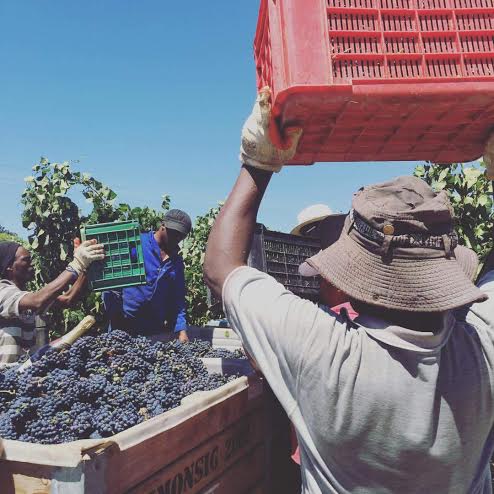Lower than normal winter rainfall in the Western Cape coupled with hot, dry conditions in spring and early summer has led to Simonsig Estate commencing its earliest harvest season on record. “We began on 11 January – 7 – 10 days earlier than average and before myself and the harvest team had a chance to pack our fishing gear away and get the sand out of our hair,” says Simonsig cellarmaster Johan Malan, who this year takes charge of his 35th harvest on the pioneering Stellenbosch wine estate.
As per usual, the first grapes to be picked are Pinot Noir used in Simonsig’s Kaapse Vonkel, South Africa’s first wine made in the naturally bottle-fermented Cap Classique style.
“The warm temperatures and dry spring caused an earlier bud-break, so we knew we were in for an early harvest, although we did not expect the dates to be moved so far forward,” says Malan. “Summer has been really hot thus far, so the grapes ripened very quickly – almost as if on turbocharge.”
Speaking on the second day of harvest, Malan says the grapes coming into the cellar are beautiful and in almost rude health. “That’s the upside of dry, hot weather – diseases are kept at bay and the grapes are pristine,” he says. “The usual fungal maladies such as oidium and downy mildew are nowhere to be seen. So if the weather conditions persist the quality of our grapes will be fantastic, and when it comes to making quality wine, healthy grapes are non-negotiable.”
The Pinot Noir analyses are, he says, brilliant: sugar at 19.4 °Balling and despite the hot weather acidity lies at 12 g/l, just the zippy freshness Cap Classique requires. The chances of acid levels ending up lower than normal as harvest progresses is a big possibility.
Malan says that the dry, hot weather will lead to yields on Simonsig’s vineyards being lower than normal due to smaller berries and subsequent lower bunch weight.
“We have had some grapes suffering from sunburn, especially bunches exposed to direct sunlight,” he says, “but as these berries drop to the ground they do not form part of the bunch ending up in the winery and do thus not affect wine quality.”
A winemaker knows that predictions are near impossible to make due to the whims of nature determining a grape harvest. However, Malan says that hot years such as 1984 and 2000 led to superb quality red wines, with Chardonnay and Chenin Blanc also delivering the goods under similar conditions. “Sauvignon Blanc likes a cool season, but on the other hand hot conditions impart a delectable tropical character to this wine,” he says.
Planning is the key. “Picking at correct levels of ripeness for each variety is paramount during a hot year,” says Malan. “We will pick at lower sugar levels so as to get better acidity as well as to keep alcohol levels down. Logistically, there is a threat that various varieties will ripen simultaneously which places huge pressure on the winery and the harvest teams.”
But experience has taught that nature always seems to throw some sort of a curve-ball. “Rain during the full moons of 24 January and 22 February is not out of the question and will bring relief from the hot conditions, and I for one am holding thumbs that this happens. As my father Frans said: ‘That’s pure must falling from the sky!’”





